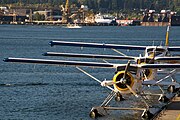|
Harbour Air
Harbour Air Seaplanes is a scheduled floatplane service, tour and charter airline based in Richmond, British Columbia, Canada. The predominantly seaplane airline specializes in routes between Vancouver, Nanaimo, Victoria, Sechelt, Comox, Whistler and the Gulf Islands, primarily with de Havilland Canada floatplanes. Harbour Air operates de Havilland Beavers, Otters and Twin Otters. History   The airline was established and started operations in 1982 as Windoak Air Service to provide seaplane charter services for the forestry industry in British Columbia. In 1993, Harbour Air purchased Trans-Provincial Airlines, added charter flights to resorts, and increased scheduled services. Today, Harbour Air refers to itself as the world's largest all-seaplane airline and became North America's first carbon neutral airline.[9] A small subsidiary, Harbour Air Malta, was set up in June 2007 and a DHC-3 Turbo Otter floatplane is permanently based in Valletta, Malta for scheduled flights to Gozo and sightseeing trips around the islands.[10] Harbour Air Magazine is the official in-flight magazine of Harbour Air.[11] In 2007, Harbour Air became the first airline in North America to achieve complete carbon neutrality in both flight services and corporate operations. Teamed up with Vancouver-based Offsetters, the airline started to include a carbon offset on each ticket used to mitigate the environmental impact of the greenhouse gas emissions (GHG's) associated with the flight. The funds are invested in renewable energy projects.[12] On February 16, 2010, Deloitte Canada announced that Harbour Air was a winner of a 2009 Canada's 50 Best Managed Companies Award.[13] This national award is sponsored by Deloitte, Canadian Imperial Bank of Commerce, National Post and Smith School of Business. On March 31, 2010, Harbour Air completed the acquisition of West Coast Air and consolidated their terminal services.[14] On May 20, 2011, Harbour Air grounded its service from Victoria Harbour to Langley Regional Airport due to low passenger numbers and fuel price surges.[15] On May 9, 2012, Harbour Air purchased Whistler Air.[16] In September 2013, Harbour Air launched a land-based charter carrier, Tantalus Air, which operated one Cessna 182 Skylane as ICAO airline designator TTU, and telephony TANTALUS.[17][18][19][20] In November 2015, Salt Spring Air was purchased by the Harbour Air Group. Salt Spring Air's fleet now joins Harbour Air, West Coast Air and Whistler Air and now claims to be largest seaplane airline in the world.[21] Harbour Air and Kenmore Air started a new seaplane service between Downtown Vancouver, and Downtown Seattle on April 26, 2018. In March 2019, Harbour Air announced a partnership with magniX to electrify the entire Harbour Air fleet over the long term.[22] Harbour Air has noted that its initial electric-powered commercial flights will be on routes of under 30 minutes' duration.[23] The first converted aircraft was a DHC-2 Beaver which serves as the test prototype for the magniX motor, energy storage, and control systems.[22] The prototype flew for the first time on December 10, 2019.[24][25] The company hopes to have the aircraft certified for commercial use by 2021.[26][27] Electric aviationIn March 2019, Harbour Air announced plans to convert an aircraft to run on electricity, which would serve as a test prototype during a two-year duration regulatory approval process, and eventually hoped to convert its entire fleet to electric propulsion. The first plane to be converted was a de Havilland Canada DHC-2 Beaver.[28] The electric prototype made its first flight over 4 minutes off the Fraser River near Vancouver on December 10, 2019. The Pratt & Whitney R-985 Wasp Junior piston engine of the six-passenger ePlane was replaced by a 560 kW (750 hp), 135 kg (298 lb) magni500, with swappable batteries allowing 30 minute flights plus 30 minutes of reserve power. Harbour Air wants to convert all its aircraft, including Beavers and Pratt & Whitney Canada PT6-powered Otters and Twin Otters.[29][needs update] Three years later, the plane completed its first point-to-point test flight, from Vancouver to Victoria Airport Water Aerodrome near Sidney on Vancouver Island, on August 18, 2022, travelling 72 km (45 mi) in 24 minutes.[30] The aircraft was displayed at the British Columbia Aviation Museum open house on August 20 the same year.[citation needed] Awards and accolades Harbour Air has won the following awards:[31][non-primary source needed]
DestinationsAs of January 2025, Harbour Air serves the following destinations (some destinations are seasonal):[8] FleetAs of January 2025, the Harbour Air fleet consisted of 41 aircraft and 43 registered with Transport Canada:[6][7][32]
Accidents and incidentsOn August 4, 1998, a de Havilland Canada DHC-2 Beaver, registration C-FOCJ, overturned after landing near Ging̱olx, at Kincolith Water Aerodrome. On the fourth approach, the floatplane touched down, apparently in a controlled manner, and skipped on the water surface. The floats then dug into the water followed by the right wing, which was severed from the fuselage on water impact. The aircraft quickly overturned. All five aboard drowned.[33] On June 8, 2024, a de Havilland Canada DHC-2 Beaver (same airframe rebuilt from the 1998 crash), registration C-FFHA collided with a boat upon takeoff at Vancouver Harbour Flight Centre.[34][35] Gallery
See alsoExplanatory notes1 AOC number is used for Harbour Air Seaplanes, Whistler Air, Salt Spring Air and West Coast Air. References
External linksWikimedia Commons has media related to Harbour Air. |
|||||||||||||||||||||||||||||||||||||||||||||||||||||||||||||||||||||||||||||||||







